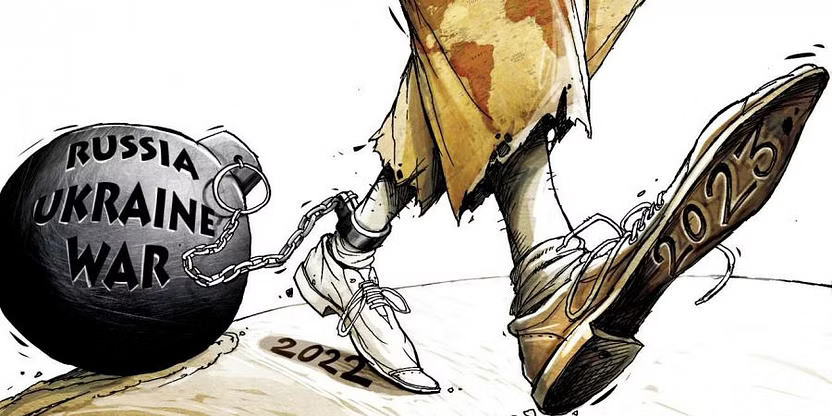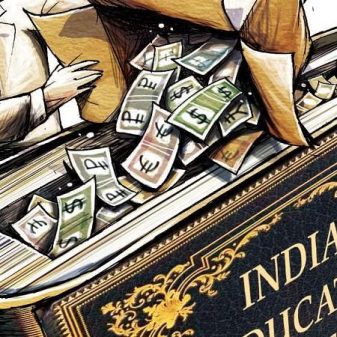
By P S Raghavan
Russia, Ukraine and NATO are locked into inflexible positions that do not permit compromise sans loss of face.
Four days before the first anniversary of Russia’s invasion of Ukraine, US President Joe Biden undertook an arduous journey to the war-torn country, across territory sporadically under Russian missile attack. It was the first time in living memory that a US President visited a warzone where US troops did not control the terrain and airspace. The visit was a powerful reconfirmation of continued US military, diplomatic and economic support for Ukraine’s sovereignty and independence.
At another level, it is reassuring that effective deconfliction protocols exist between the US and Russia, even amid this ferocious war. US NSA Jake Sullivan said the Russians had been informed before the visit. Reliable communication channels may help to prevent a local misadventure or miscalculation from escalating to a major conflagration.
Sullivan said Biden had assured President Zelensky that his strategy of forging a coalition of countries to extend military, economic, and humanitarian support to Ukraine would endure. It has indeed been a remarkable achievement to hold such a diverse group together, persuading countries to take action and adopt policies that involved a considerable sacrifice of their immediate economic interests and, in some cases, with long-term economic consequences—as with Germany, which quietly acquiesced in the sabotage of not only the newly built Nord Stream 2 gas pipeline from Russia but also the older Nord Stream 1, which had been supplying gas for decades.
It has often been said that President Putin would have counted on Europe to be divided in its response to Russia’s invasion. This may or may not be so, but he would almost certainly not have expected the extent to which European countries closed ranks to support Ukraine. It has been an extraordinary show of solidarity, sinking old differences, suppressing self-doubt, accepting economic sacrifices and making bold political decisions with far-reaching impacts. There were some wrinkles in the decision-making process on sanctions. Still, the 27 countries of the European Union eventually united behind a formidable menu of sanctions across economic, financial and industrial sectors.
Moreover, many European companies went beyond the requirement and voluntarily suspended business with Russia, even with companies in third countries sourcing their products from Russia. Russian professional, cultural and sports organisations were boycotted; individual professionals, athletes and artists were barred from events. Where they did participate, the Russian flag could not be flown, and its anthem could not be played. It was a unique manifestation of cancel culture—an entire nation was cancelled for the sins of its political leadership.
In contrast, the Ukrainian flag flies in almost every European country alongside its national and EU flags. Ukraine’s president has addressed more parliaments and international organisations in one year than most national leaders would expect to do in their lifetime.
Biden’s visit followed a recent NATO decision to significantly ramp up military assistance to Ukraine, with ammunition, armoured battle tanks and integrated air and missile defence systems. Meanwhile, former NATO generals and some European leaders are asking for more: fighter aircraft, drones, long-range artillery and more lethal weaponry to ensure a Russian defeat.
Views of various NATO leaders on the endgame in this war vary in emphasis and nuance, depending on their geopolitical perspectives: Ukraine should not be allowed to lose; Ukraine should win; Russia cannot and must not win; Russia should be defeated, pushed out of all occupied Ukrainian territory and weakened to the extent that it can never threaten its neighbours again. Regime change and the disintegration of Russia are often seen as desired outcomes. Among European leaders, France’s President Emmanuel Macron has been a relative outlier (and has taken the flak for it): saying that Russia’s security concerns must be accommodated “at some stage”.
The course of NATO’s military support to Ukraine would be influenced by the line it finally embraces for the endgame. There was not much clarity on this in briefings on the Biden-Zelensky conversation. It was said they talked about capabilities Ukraine needs in the coming months to succeed on the battlefield (success not being defined). They also discussed Ukraine’s energy, infrastructure, economic and humanitarian needs, which would surely cost a few billion dollars.
On his part, Putin has again reiterated his determination to win the war, declaring that the US-led West has thrust it on Russia and that it is now an existential issue for his country. That Russia mishandled military tactics, personnel and equipment for much of the war is obvious and was implicit in Putin’s speech. The political misjudgement is also evident: Ukrainians did not receive the Russian army with open arms, and European unity did not fracture. The real issue of long-term consequence is how the war’s outcome will impact the strategic interests of Russia, Ukraine, Europe and the US. The jury is still out on this issue.
Therefore, the stark reality is that all stakeholders—Russia, Ukraine and NATO countries—are locked into inflexible positions that do not permit compromise without loss of face.
An assumption that the economic impact of the war (and the sanctions) would drive its protagonists towards compromise proved unfounded. According to the IMF, the US and European economies avoided recession; Europe adapted reasonably to the energy crisis; and even the Russian economy contracted less than expected.
Mediation efforts of Israeli, French and Turkish leaders petered out quickly. Turkey catalysed a tentative Russia-Ukraine agreement in March-end last year, which reportedly envisaged a “neutral, non-aligned and non-nuclear” Ukraine, guaranteed by all stakeholders (essentially NATO and Russia). But it was soon buried, as Ukraine was apparently persuaded that it could secure a better outcome on the battlefield.
Zelensky unveiled a “peace plan” at the G20 summit in November. It involves Russia withdrawing from all Ukrainian territory, an international tribunal to try Russian war crimes, and reparations for damage caused by its aggression, including confiscation of Russian assets. This presupposes a military collapse and surrender of the Russian State.
In sum, therefore, one year into the Russian military action, the underlying causes have not been addressed, large-scale destruction continues, regional conflicts have mushroomed, globalisation is subjugated to geopolitics, multilateralism has degenerated, energy transition is under threat and a rules-based, multipolar world order is little more than a pipedream. This is the depressing geopolitical report card of 2022 and defines a formidable agenda for 2023.
(The writer is Chairman, National Security Advisory Board of India.Foundation, and a former diplomat)





